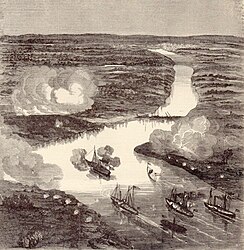Battle of Drury's Bluff
| Battle of Drewry's Bluff | |||||||
|---|---|---|---|---|---|---|---|
| Part of the American Civil War | |||||||
 |
|||||||
|
|||||||
| Belligerents | |||||||
|
|
|
||||||
| Commanders and leaders | |||||||
|
|
|
||||||
| Strength | |||||||
| 3 ironclads 2 gunboats |
~7 artillery pieces 1 fort 1 shore battery |
||||||
| Casualties and losses | |||||||
| 2 ironclads damaged 1 gunboat damaged 24 killed or wounded |
1 fort damaged 15 killed or wounded |
||||||
The Battle of Drewry's Bluff, also known as the Battle of Fort Darling, or Fort Drewry, took place on May 15, 1862, in Chesterfield County, Virginia, as part of the Peninsula Campaign of the American Civil War. Five Union Navy warships, including the ironclads USS Monitor and Galena, steamed up the James River to test the defenses of Richmond, Virginia, the Confederate capital. They encountered submerged obstacles, and deadly accurate fire from the batteries of Fort Darling at Drewry's Bluff, which inflicted severe damage on Galena, forcing them to turn back.
In the spring of 1862, Union Major General George B. McClellan launched an amphibious operation against Richmond by landing troops at Fort Monroe and then marching northwest up the Virginia Peninsula. After the fall of Yorktown and the withdrawal of General Joseph E. Johnston's army up the Peninsula, only the Confederate Navy ironclad CSS Virginia prevented Union occupation of the lower James River and Norfolk. When the Confederate garrison at Norfolk was evacuated by Maj. Gen. Benjamin Huger on May 10, Commodore Josiah Tattnall knew that he could not navigate Virginia through the shallow stretches of the James River toward Richmond, so she was scuttled on May 11 off Craney Island to prevent her capture. This opened the James River at Hampton Roads to Federal gunboats.
...
Wikipedia
